Survey Says: Yes, Everyone Really Is Binge-Watching A Lot More Netflix (And Cutting Back Cable)
PriceWaterhouseCoopers today released the results from a survey they conducted this year on “consumer attitudes toward video content and corresponding behavioral shifts.” In other words: what are we watching, where and when are we watching it, and how has it changed?
The results (PDF) are exactly what you suspect they are. Overall, traditional TV viewership is slowly declining and online streaming — and binge watching in particular — are on the rise. “The videoquake is here,” PWC concludes, particularly (and predictably) among younger adults.
Adults 35-49 and 50-59 have maintained or increased their cable subscriptions, but for the 18-35 set the number who subscribe to cable TV has dropped about 6%: from nearly 3/4 of the 25-34 set (73%) to closer to 2/3 (67%). Meanwhile subscriptions to Netflix, Amazon Prime, and Hulu are all up — Netflix most dramatically so, with a 25% increase in subscribers since last year.
Meanwhile, if you accidentally (or intentionally) finished the entire run of your favorite series in a single weekend this year, you’re in good company: a solid half of the participants in the survey self-identified as binge-viewers. And binge-viewing is on the rise: 55% of respondents said they do it more often now than they did last year. Young adults are again more likely than their older peers to take in a big block of programming all at once. Though taking in three or more back-to-back episodes of a show is something most of us apparently do at least once a month, 53% of the 18-24 set reported doing it at least weekly or even daily.
Of course, cable vs. Netflix it doesn’t have to be an either-or scenario, and the data reinforce that. Plenty of people have both a pay TV service (cable, satellite, or fiber) and also subscribe to Netflix. Across all age groups, 60% – 70% of pay TV users also subscribe to Netflix. The most notable year-over-year increase is among older adults age 50-59: in 2013 just 19% of the pay TV subscribers in that group also had Netflix, but in 2014 a whopping 58% reported having both.
PWC also tried asking why viewers are frustrated with or turning away from traditional pay TV subscriptions. The result? 41% of participants said they were tired of paying for networks they never watch and don’t need, and want the ability to build a la carte bundles. The average cable subscriber gets 189 channels, PWC says, but on average watches fewer than 20 of them.
But unbundling, and a shift to online or on-demand programming from traditional networks, may not save consumers much money in the long run. Channel lineups are determined as part of massive contract negotiations (for now, anyway), and if content companies can’t get their smaller networks included as part of an agreement with the Comcasts of the world then the costs for their flagship, high-demand networks may well increase. Likewise, internet TV will probably not be cheap, and it still comes with plenty of chances for arguments between corporations to increase costs and decrease service to the subscriber.
Still, despite the challenges, the way we get our comedies, dramas, and reality TV is clearly going to keep changing. 91% of respondents said they’d still have cable in a year’s time, but only 61% said they’d probably still have it in 5 years. Less than half of participants, a mere 42%, said they could see themselves still subscribing to cable ten years from now.
Want more consumer news? Visit our parent organization, Consumer Reports, for the latest on scams, recalls, and other consumer issues.


